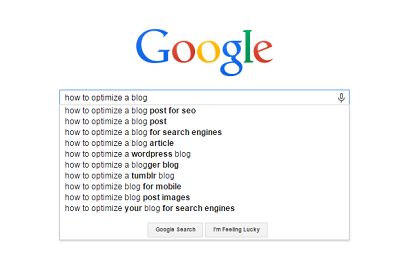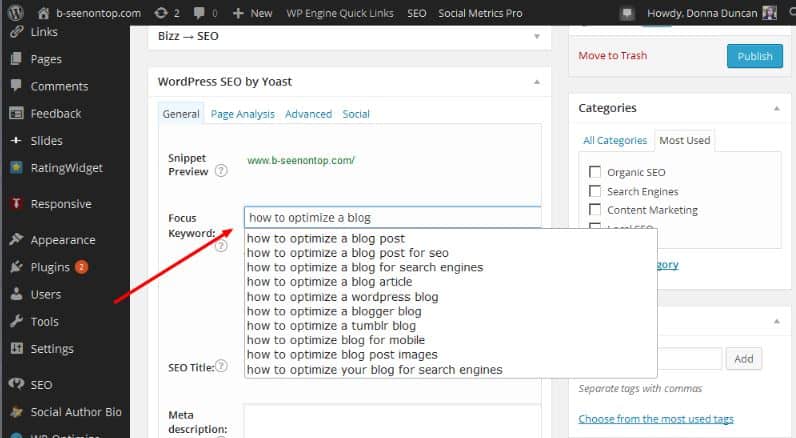Estimated Read Time: 4 Minutes
Here’s How It Used To Work
The Yoast SEO plugin is a popular tool among search engine optimization specialists and bloggers. It helps users optimize their website and suggests popular words and phrases (keywords) people might be using to search for your goods and/or services. You can include those keywords in your blog posts and increase your chances of being eligible to rank on Google.
Or at least that’s how it used to work.
If you tried to use the Yoast SEO plugin to discover keyword phrases today, you might incorrectly assume it was broken.
It’s not broken.
It’s been unplugged / disabled.
By Google.
The Google Autocomplete API
There is a field in the Yoast SEO plugin called focus keyword. Before August 10, you could use the focus keyword field to type a short phrase that best summarized the content of your blog post and Yoast would show you popular search phrases trending on Google.
The technology that enabled the retrieval of search phrase suggestions is called the Google Autocomplete application program interface (API). It’s basically a doorway into real search data on Google.
You’ve probably used the API and just not been aware of it. When you type a search phrase into Google Search, the autocomplete API displays popular search terms in a popup window below. Results are displayed in descending order of search volume, the most popular search phrases closest to the top.
Here’s an example.

When I type “how to optimize a blog” into Google search, the API retrieves popular keyword phrases that match my query and displayed them in a popup window below. The most popular phrase trending on Google at the time of my search was “how to optimize a blog post for seo”.
Now compare that to how the focus keyword field used to work on Yoast.

When I typed the phrase “how to optimize a blog” into the Yoast focus keyword field, popular search phrases that matched my query were displayed in a popup window below. The slight difference you see between the phrases and their order is due to timing differences. The snapshot of the Yoast tool above is from earlier this summer, before Google decided to disable their API.
Google’s Announcement
On July 24, 2015 Google announced the autocomplete application program interface (API) Yoast and others used to provide keyword suggestions would no longer be available effective August 10.
Here is Google’s explanation:
We built autocomplete as a complement to Search, and never intended that it would exist disconnected from the purpose of anticipating user search queries. Over time we’ve realized that while we can conceive of uses for an autocomplete data feed outside of search results that may be valuable, overall the content of our automatic completions are optimized and intended to be used in conjunction with web search results, and outside of the context of a web search don’t provide a meaningful user benefit.
Doesn’t Provide a Meaningful User Benefit
The beauty of the Yoast focus keyword lookup functionality was its ease and simplicity.
You didn’t have to step outside of WordPress to brainstorm and come up with keyword suggestions. You didn’t have to find, assess, pay for, or learn a separate keyword tool. You just keyed your topic into the focus keyword field and picked the phrase that best reflected the content of your blog post.
It was quick and easy. Like plugging a cord into an electrical outlet.
What You Can Do Instead
I suspect I’m not the only one mourning the loss of this ‘unmeaningful benefit”. You know how I can tell? I typed “Yoast focus keyword” into a Google search window, and look what came up.

“Yoast focus keyword field not working” is the second most popular search term trending on Google right now. That suggests others are at least wondering what’s going on and probably looking for an alternative.
So what can you do about it?
Google suggests using their custom search engine – the tool that enables search within a website using Google technology. Presumably the autocomplete functionality remains active there.
That isn’t going to help us, unfortunately. It taps into a single website’s internal search query data, not real searches performed by real people all around the world. But there is an alternative, and it’s right in front of our face.
Use Google Search. You can use Google search the same way I did above when I typed “how to optimize a blog” and “Yoast focus keyword” into the search engine. It’s not as convenient because you have to step outside of WordPress and the Yoast SEO tool, but you’ll get the same results.
So there you have it. The Yoast focus keyword field is not broken. It’s been unplugged / disabled by Google and you’ll need to step outside of WordPress and Yoast if you want to come up with keyword suggestions.
It’s not the end of the world, just a nuisance.
IMAGE CREDIT: Featured Image courtesy of Brittany Lynne Photography on Flickr







Leave A Comment